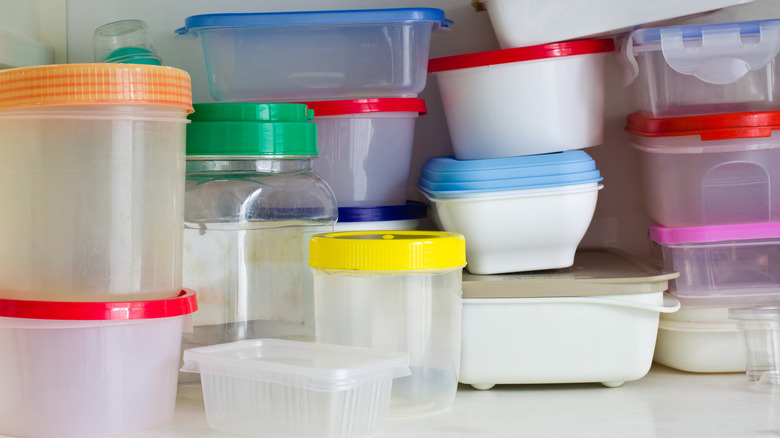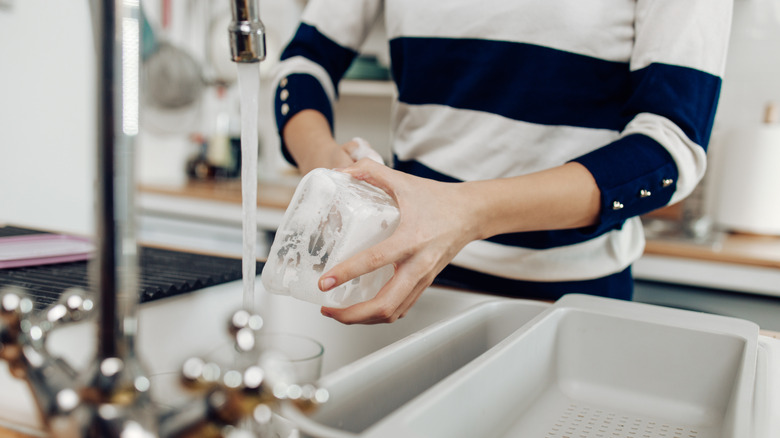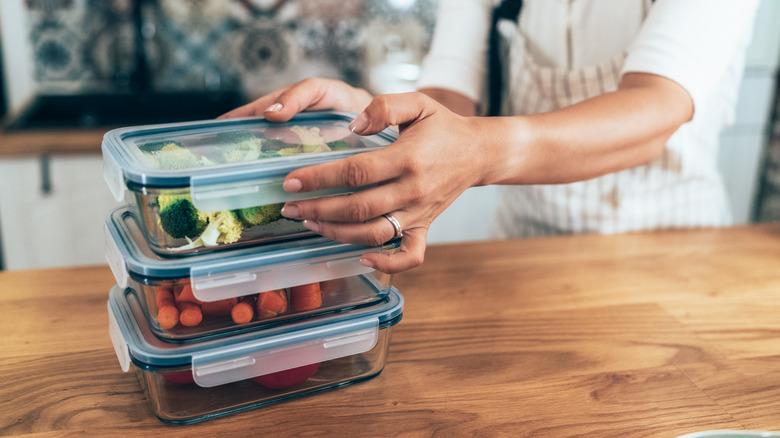Pinterest's Alka-Seltzer Hack Leaves Stained Food Containers Looking Brand New
You've just finished dinner and it's time to put the leftovers away in the fridge for tomorrow's lunch. You reach into that god-awful drawer, bursting with mismatched plastic food storage containers, and swish through the many shapes and sizes until you've finally got a matching top and bottom. Upon inspection, you notice the container isn't that clean, despite having run it through the dishwasher. This universal human experience is an everyday occurrence for most of us and is a result of the porous nature of plastics and the presence of pigments in certain foods. Highly pigmented foods, such as tomato-based sauces, berries, and spices like turmeric, have intense colors that can adhere to container surfaces. The porous structure of plastic allows these pigments to penetrate, causing stains. Fortunately, pinned away on Pinterest is a hack using Alka-Seltzer to remove these stubborn stains and leave your containers looking brand new.
Alka-Seltzer is useful in removing food stains from storage containers due to its effervescent properties. The fizzing action helps break down stubborn stains and lift them from the container surfaces. The combination of baking soda and citric acid in Alka-Seltzer creates a bubbling effect that works effectively against various types of food residues. This gentle yet efficient cleaning process helps eliminate stains without damaging the container material. Alka-Seltzer's versatility makes it a convenient, affordable, and accessible solution for tackling those pesky food stains, providing an easy and effective method for maintaining clean and stain-free storage containers.
How to clean your containers with Alka-Seltzer
To remove stains from plastic food storage containers, begin by ensuring that the container is empty and free of any loose debris. Fill the stained container with warm water, leaving enough space to drop in an Alka-Seltzer tablet. The water should be warm but not boiling, as extreme temperatures may affect the plastic. Drop one or two Alka-Seltzer tablets into the water-filled container. The effervescent reaction will begin immediately, creating bubbles that help loosen and lift the stains.
Allow the Alka-Seltzer tablets to dissolve completely, and let the solution sit in the container for one to two hours. This soaking time allows the effervescence to work on the stains effectively. For more stubborn stains, you can let the solution soak overnight. After the soaking period, use a sponge or soft-bristle brush to scrub the container's interior, focusing on areas with visible stains. The effervescent reaction, along with the agitation from scrubbing, aids in dislodging and removing the stains.
Once you've scrubbed the container thoroughly, empty the solution and rinse it with clean water. Ensure that all Alka-Seltzer residue is washed away. If any stains persist, repeat the process until the desired cleanliness is achieved. This method is particularly effective for common stains caused by oily or greasy foods in addition to coffee, wine, and tea. Nevertheless, regular maintenance of your storage containers with Alka-Seltzer can help keep them stain-free and in great condition for reuse.
How to avoid stains on food storage containers
While Alka-Seltzer is a cheap and easy solution to removing stubborn stains from food storage containers, there are several ways you can actually prevent the containers from staining in the first place. One effective way is by using an unflavored cooking spray. Before placing food in a container, simply coat the interior with a thin layer of unflavored cooking spray. This creates a barrier between the plastic surface and the pigments in the food, making it more difficult for stains to adhere. The cooking spray essentially acts as a protective layer, reducing the likelihood of intense colorants from foods like tomato-based sauces or oily dishes sticking to the container. This method is particularly useful for plastic containers and ensures that they remain stain-resistant with minimal effort.
Another approach to preventing food stains is opting for glass containers instead of plastic ones. Glass is non-porous, which means it lacks tiny openings that can absorb pigments from certain foods. Unlike plastic, glass does not retain colors or odors from previous contents, making it less prone to staining. Glass containers are also resistant to oils and acidic foods, reducing the chances of persistent stains. Additionally, glass is more durable, scratch-resistant, and easier to clean, making it a superior choice for maintaining the appearance and cleanliness of food storage containers over time. Though glass containers may be a bit heavier and more expensive, their stain-resistant properties and overall durability make them a worthwhile investment.


